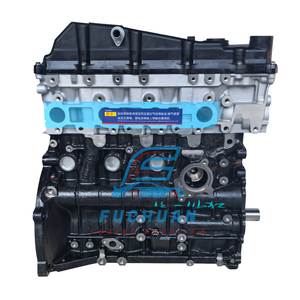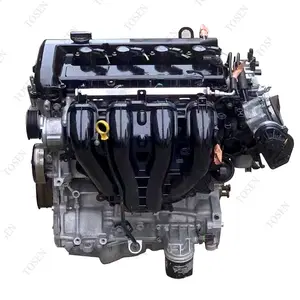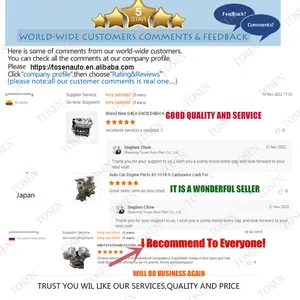(801 products available)























































































































































































2KD-FTV engines are categorically divided based on the type of cooling system used in the engine. They include:
Liquid-cooled 2KD-FTV engines
Liquid-cooled 2KD-FTV engines use a cooling system that relies on the circulation of coolant (water and antifreeze mixture) through the engine block and cylinder head. The coolant absorbs heat generated during combustion and carries it to a radiator, where it is dissipated by airflow. These engines provide precise temperature control, reducing the risk of overheating and enabling optimal performance across various operating conditions.
Air-cooled 2KD-FTV engines
2KD-FTV engines are less common and mainly used in some older or specialized KD series vehicles. These engines rely on the circulation of air over the engine's external surface to maintain optimal temperatures. They are simpler in design compared to liquid-cooled engines, making them more cost-effective and easier to maintain. However, air-cooled 2KD-FTV engines have more limitations, such as temperature fluctuations and restricted performance in high-temperature settings.
Another way to categorize the 2KD D4D engine is by the number of cylinders, which are all 4. In this case, 2KD-FTV engines are the most common inline 4-cylinder diesel engines. They are also well-known as 4-cylinder D4-D engines. Some newer models may utilize a 4-cylinder V engine layout. Regardless of the number of cylinders, all 2KD D4D engines have a dual overhead camshaft (DOHC) design, enhancing their ability to generate power and torque.
Regular Oil Changes:
Engine oil lubricates and protects internal engine parts. Follow the recommended oil change intervals using the right oil type. This keeps the engine smooth and reduces wear.
Air Filter Maintenance:
The air filter prevents dirt from entering the engine. Check it regularly and replace it when worn. A clean air filter helps fuel burn properly and keeps the engine running efficiently.
Cooling System Care:
The cooling system stops the engine from overheating. Make sure there is enough coolant and the system works well. Overheating can damage engine parts over time.
Scheduled Tune-Ups:
Tune-ups at recommended mileage keep the engine in top shape. Technicians check and adjust things like spark plugs, fuel system, and more. This optimizes performance and prevents future problems.
Using Quality Replacement Parts:
When changing parts, use high-quality or OEM ones. These are made to the same standards as the originals. Quality parts ensure everything fits and works correctly, unlike cheap imitations.
Monitoring Warning Signs:
Be alert to any dashboard lights or strange engine sounds/vibrations. Issues detected early can often be fixed easily before becoming major. Regular driving and visual inspections help spot issues promptly.
Check and Replace Belts and Hoses:
Parts like timing belts, accessory belts, and rubber hoses wear out over time. They should be inspected regularly for cracks, fraying, leaks, etc. Any damaged ones need timely replacement before they break down and cause other problems.
Fuel System Maintenance:
The fuel filter needs occasional changing, and using good quality fuel is essential. This keeps the fuel lines and injectors clean, providing the engine with the right amount of gasoline.
By following these simple tips, users can maintain the Toyota 2KD-FTV engine well and get the most out of its power.
There are several factors to consider when choosing any of the 2KD D4D engines for resale. First, look at the customer needs and preferences. What are they mostly looking for? Go through the specifications that match their requirements. Are they interested in the power output and torque or fuel efficiency?
Another factor to consider is the condition of the engine. Engine parts in good condition have a higher resale value. However, the engines with interchangeable parts, whether in good condition or damaged, are likely to attract more customers. Therefore, choose the 2KD D4D engines based on the target market.
Additionally, inspect the engine for damage. Take a close look at the external parts of the engine to see if there are any signs of wear, cracks or corrosion. Damage to the engine may result in costly repairs or complete engine failure.
It's also important to consider the installation process. Some 2KD D4D engines are easy to install, while others require expertise and more effort. Reselling engines that are easy to install will be less challenging and more profitable. Last but not least, consider the pricing of the engine. Choose engines that will give a good profit margin.
Replacing a 2KD-DFD engine can be a complicated process. It requires professional expertise and special tools. However, here are some simple steps to help make the process easier:
Disconnect the battery:
Start by disconnecting the battery. This will prevent any electrical connections that could interfere with the replacement process.
Drain fluids:
Drain all the fluids from the engine, including oil and coolant. This will prevent any leaks or spills during the replacement process.
Remove the air intake:
Once that is done, the next step is to remove the air intake system. This will provide access to the engine.
Disconnect the fuel lines:
At this point, one can now disconnect the fuel lines from the engine. This will prevent any fuel leaks during the replacement process.
Electrical connections:
one should disconnect all the electrical connections to the engine. This includes sensors and the wiring harness. This will disconnect the power supply to the engine.
Remove the exhaust system:
Remove the exhaust system to gain access to the engine's underside.
Remove the engine mounts:
Remove the engine mounts that hold the engine in place. This will allow the engine to be loosened and removed from the engine bay.
Raise the engine:
use a hoist or jack to raise the engine and disconnect it from the vehicle. This will allow the engine to be lifted and removed from the vehicle.
Install the new engine:
Place the new 2KD-DFD engine onto the mounts and connect it to the engine bay. This will ensure a secure and stable connection to the vehicle.
Reconnect all systems:
reconnect all electrical, fuel, air, and exhaust systems. This will ensure that all systems are connected and functioning properly.
Refill fluids:
Refill the engine with oil and the cooling system with coolant. This will ensure that the engine is properly lubricated and cooled.
Check for leaks:
Check for any signs of leaks or spills. This will ensure that the replacement process was successful and that the engine is functioning properly.
Reconnect the battery:
Reconnect the battery and start the engine. This will ensure that the engine is running and functioning properly.
Q1. How can users know if their vehicles have 2KD D-4D engines?
A1. Users can check their vehicle's owner's manual to see the engine details. They can also contact the manufacturers or visit their official websites to get more information. They can open the hood and check the engine nameplate to see the 2KD D-4D engine. It is located on the engine block and indicates whether the engine is a 2KD D-4D engine or not.
Q2. What is the meaning of D-4D in the 2KD D-4D engine?
A2. The D-4D indicates that the engine uses a direct common rail diesel injection. The system sprays fuel into the combustion chamber at high pressure. The D-4D system improves fuel efficiency and performance.
Q3. What are the common problems of the 2KD D-4D engines?
A3. The major problems of the 2KD D-4D engines are similar to those of the 2KD engines. They include turbocharger failure, injector failure, and piston slap. The turbocharger failure makes it hard for the engine to generate power. The injector failure causes the engine to misfire. The piston slap creates noise in the engine. Users should consult mechanics to get solutions for these problems.
Q4. Do all 2KD D-4D engines have the same performance?
A4. No! Different manufacturers tune the 2KD D-4D engines to meet their performance requirements. The engine performance details include power output, torque, and speed. The performance may also differ depending on the engine's condition, maintenance level, and other factors.